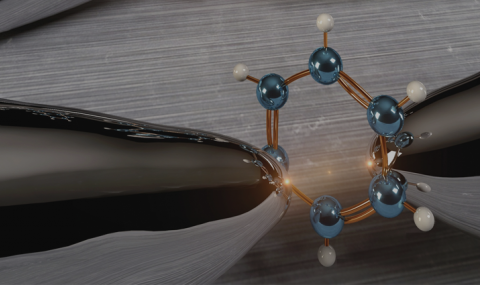The inherent electronic mismatch between molecules and metals is a general limitation for efficient electron transport in molecule-based electronics, including organic photovoltaic cells, organic light emitting diodes and single-molecule transistors. To date, the study of electronic transport across metal-molecule interfaces focused on low conductance governed by tunneling or hoping processes. Recently, we fabricated a series of highly transmitting single-molecule junctions in order to study the upper limit of conductance across metal-molecule interfaces. We revealed two fundamental mechanisms for conductance saturation near full electron transmission. These mechanisms can be used to optimize efficient charge injection, information transfer and recombination processes across metal-molecule interfaces (T. Yelin et al. Nature Materials 15, 444 (2016)).
In order to study the conductance characteristics of highly transmitting molecular junctions we formed a set of single molecule junctions based on oligoacenes molecules with increasing length (1 to 6 benzene rings fused in a row). The molecules were directly connected to metal electrodes, without employing anchoring groups such as thiols that can act as spacers between the orbitals of the molecular backbone and the frontier orbitals of the metal. We found that the conductance saturates at an upper limit where it is independent of molecule length. With the aid of two prototype systems, in which the molecules are contacted by either Ag (s metal) or Pt (s-d metal) electrodes, we revealed two fundamental mechanisms for conductance saturation.
Ag/oligoacene junctions yield a non-trivial conductance trend, where the conductance first increases with molecule length, followed by the onset of conductance saturation. This result can be reproduced by a simple model: Considering pi conjugated molecules in terms of a simple “particle in a box” model, longer molecules have a lower level spacing (as justified by optical measurements), which improves the level alignment with the energy states of the metal that participate in electronic transport. This trend acts to enhance the conductance for longer molecules. However, as the molecule length increases, the molecular orbital that dominates the transport is further extended over a longer molecule with lower probability density at the electrodes. This trend acts to reduce the metal-molecule electronic coupling and hence the conductance across the metal-molecule interfaces. We found that the first trend is dominant for small molecules, leading to enhancement of conductance as the molecule length increases. Surprisingly, for long enough molecules (in our case, longer than 3 benzene rings), the two trends cancel each other and the conductance become independent of the molecule length, reaching an upper limit of about 0.6G0.
In contrast, the conductance of Pt/oligoacene junctions does not depend on the molecule length, and it is approximately equal to the conductance quantum G0 for all the examined molecules. Here, efficient pi-d hybridization smears the molecular and metal resonances to give high and energetically wide transmission that is not very sensitive to variations in the molecular level positions along the oligoacene series. The molecular junctions become essentially “metallic” with a band-like transmission.
These findings illustrate the mechanisms that can constrain the conductance at the high transmission limit for molecular junctions and suggest guiding principles for the design of highly conductive metal-molecule interfaces. By an appropriate choice of metal electrodes with specific symmetry of its frontier orbitals, one can either obtain tunable conductance at G<Go or robust metallic conductance at 1Go. In the first case, the conductance can be set by the molecular electronic structure, while in the second case the conductance is insensitive to the exact molecular electronic features.


